Marius Miron
Crossing the Species Divide: Transfer Learning from Speech to Animal Sounds
Sep 04, 2025Abstract:Self-supervised speech models have demonstrated impressive performance in speech processing, but their effectiveness on non-speech data remains underexplored. We study the transfer learning capabilities of such models on bioacoustic detection and classification tasks. We show that models such as HuBERT, WavLM, and XEUS can generate rich latent representations of animal sounds across taxa. We analyze the models properties with linear probing on time-averaged representations. We then extend the approach to account for the effect of time-wise information with other downstream architectures. Finally, we study the implication of frequency range and noise on performance. Notably, our results are competitive with fine-tuned bioacoustic pre-trained models and show the impact of noise-robust pre-training setups. These findings highlight the potential of speech-based self-supervised learning as an efficient framework for advancing bioacoustic research.
NatureLM-audio: an Audio-Language Foundation Model for Bioacoustics
Nov 11, 2024
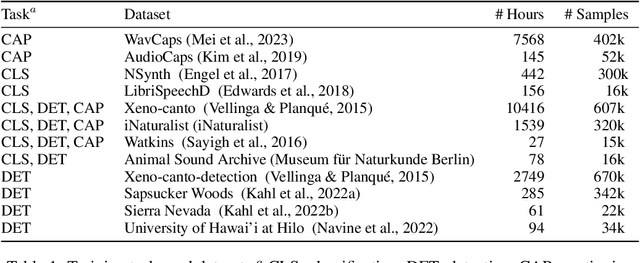

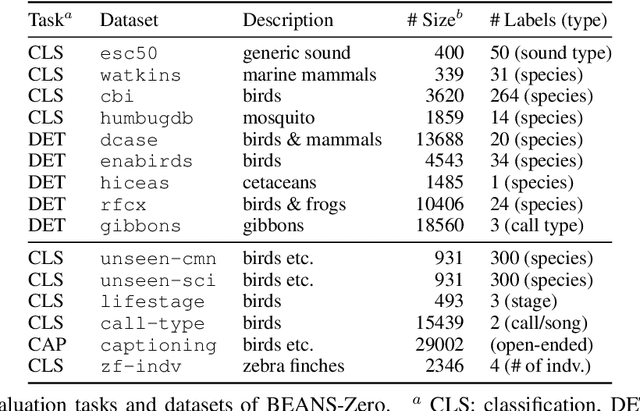
Abstract:Large language models (LLMs) prompted with text and audio represent the state of the art in various auditory tasks, including speech, music, and general audio, showing emergent abilities on unseen tasks. However, these capabilities have yet to be fully demonstrated in bioacoustics tasks, such as detecting animal vocalizations in large recordings, classifying rare and endangered species, and labeling context and behavior - tasks that are crucial for conservation, biodiversity monitoring, and the study of animal behavior. In this work, we present NatureLM-audio, the first audio-language foundation model specifically designed for bioacoustics. Our carefully curated training dataset comprises text-audio pairs spanning a diverse range of bioacoustics, speech, and music data, designed to address the challenges posed by limited annotated datasets in the field. We demonstrate successful transfer of learned representations from music and speech to bioacoustics, and our model shows promising generalization to unseen taxa and tasks. Importantly, we test NatureLM-audio on a novel benchmark (BEANS-Zero) and it sets the new state of the art (SotA) on several bioacoustics tasks, including zero-shot classification of unseen species. To advance bioacoustics research, we also open-source the code for generating training and benchmark data, as well as for training the model.
Biodenoising: animal vocalization denoising without access to clean data
Oct 04, 2024Abstract:Animal vocalization denoising is a task similar to human speech enhancement, a well-studied field of research. In contrast to the latter, it is applied to a higher diversity of sound production mechanisms and recording environments, and this higher diversity is a challenge for existing models. Adding to the challenge and in contrast to speech, we lack large and diverse datasets comprising clean vocalizations. As a solution we use as training data pseudo-clean targets, i.e. pre-denoised vocalizations, and segments of background noise without a vocalization. We propose a train set derived from bioacoustics datasets and repositories representing diverse species, acoustic environments, geographic regions. Additionally, we introduce a non-overlapping benchmark set comprising clean vocalizations from different taxa and noise samples. We show that that denoising models (demucs, CleanUNet) trained on pseudo-clean targets obtained with speech enhancement models achieve competitive results on the benchmarking set. We publish data, code, libraries, and demos https://mariusmiron.com/research/biodenoising.
ISPA: Inter-Species Phonetic Alphabet for Transcribing Animal Sounds
Feb 05, 2024Abstract:Traditionally, bioacoustics has relied on spectrograms and continuous, per-frame audio representations for the analysis of animal sounds, also serving as input to machine learning models. Meanwhile, the International Phonetic Alphabet (IPA) system has provided an interpretable, language-independent method for transcribing human speech sounds. In this paper, we introduce ISPA (Inter-Species Phonetic Alphabet), a precise, concise, and interpretable system designed for transcribing animal sounds into text. We compare acoustics-based and feature-based methods for transcribing and classifying animal sounds, demonstrating their comparable performance with baseline methods utilizing continuous, dense audio representations. By representing animal sounds with text, we effectively treat them as a "foreign language," and we show that established human language ML paradigms and models, such as language models, can be successfully applied to improve performance.
Combining piano performance dimensions for score difficulty classification
Jun 14, 2023



Abstract:Predicting the difficulty of playing a musical score is essential for structuring and exploring score collections. Despite its importance for music education, the automatic difficulty classification of piano scores is not yet solved, mainly due to the lack of annotated data and the subjectiveness of the annotations. This paper aims to advance the state-of-the-art in score difficulty classification with two major contributions. To address the lack of data, we present Can I Play It? (CIPI) dataset, a machine-readable piano score dataset with difficulty annotations obtained from the renowned classical music publisher Henle Verlag. The dataset is created by matching public domain scores with difficulty labels from Henle Verlag, then reviewed and corrected by an expert pianist. As a second contribution, we explore various input representations from score information to pre-trained ML models for piano fingering and expressiveness inspired by the musicology definition of performance. We show that combining the outputs of multiple classifiers performs better than the classifiers on their own, pointing to the fact that the representations capture different aspects of difficulty. In addition, we conduct numerous experiments that lay a foundation for score difficulty classification and create a basis for future research. Our best-performing model reports a 39.47% balanced accuracy and 1.13 median square error across the nine difficulty levels proposed in this study. Code, dataset, and models are made available for reproducibility.
Music Rearrangement Using Hierarchical Segmentation
May 12, 2023Abstract:Music rearrangement involves reshuffling, deleting, and repeating sections of a music piece with the goal of producing a standalone version that has a different duration. It is a creative and time-consuming task commonly performed by an expert music engineer. In this paper, we propose a method for automatically rearranging music recordings that takes into account the hierarchical structure of the recording. Previous approaches focus solely on identifying cut-points in the audio that could result in smooth transitions. We instead utilize deep audio representations to hierarchically segment the piece and define a cut-point search subject to the boundaries and musical functions of the segments. We score suitable entry- and exit-point pairs based on their similarity and the segments they belong to, and define an optimal path search. Experimental results demonstrate the selected cut-points are most commonly imperceptible by listeners and result in more consistent musical development with less distracting repetitions.
PodcastMix: A dataset for separating music and speech in podcasts
Jul 15, 2022



Abstract:We introduce PodcastMix, a dataset formalizing the task of separating background music and foreground speech in podcasts. We aim at defining a benchmark suitable for training and evaluating (deep learning) source separation models. To that end, we release a large and diverse training dataset based on programatically generated podcasts. However, current (deep learning) models can incur into generalization issues, specially when trained on synthetic data. To target potential generalization issues, we release an evaluation set based on real podcasts for which we design objective and subjective tests. Out of our experiments with real podcasts, we find that current (deep learning) models may have generalization issues. Yet, these can perform competently, e.g., our best baseline separates speech with a mean opinion score of 3.84 (rating "overall separation quality" from 1 to 5). The dataset and baselines are accessible online.
Score difficulty analysis for piano performance education based on fingering
Mar 24, 2022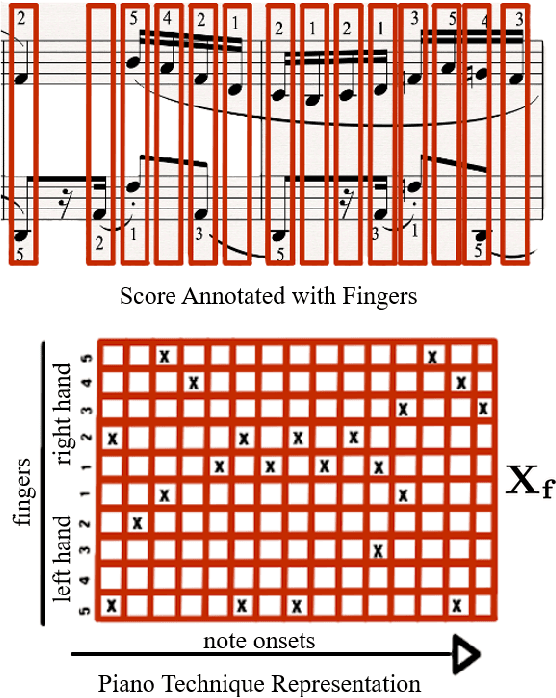
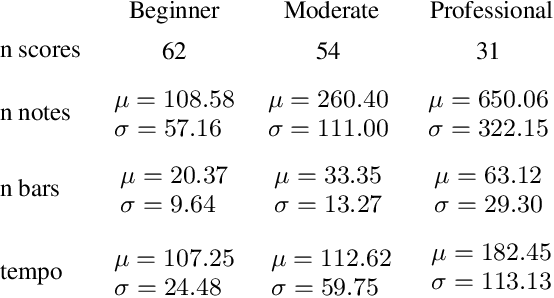


Abstract:In this paper, we introduce score difficulty classification as a sub-task of music information retrieval (MIR), which may be used in music education technologies, for personalised curriculum generation, and score retrieval. We introduce a novel dataset for our task, Mikrokosmos-difficulty, containing 147 piano pieces in symbolic representation and the corresponding difficulty labels derived by its composer B\'ela Bart\'ok and the publishers. As part of our methodology, we propose piano technique feature representations based on different piano fingering algorithms. We use these features as input for two classifiers: a Gated Recurrent Unit neural network (GRU) with attention mechanism and gradient-boosted trees trained on score segments. We show that for our dataset fingering based features perform better than a simple baseline considering solely the notes in the score. Furthermore, the GRU with attention mechanism classifier surpasses the gradient-boosted trees. Our proposed models are interpretable and are capable of generating difficulty feedback both locally, on short term segments, and globally, for whole pieces. Code, datasets, models, and an online demo are made available for reproducibility
Soundata: A Python library for reproducible use of audio datasets
Oct 04, 2021Abstract:Soundata is a Python library for loading and working with audio datasets in a standardized way, removing the need for writing custom loaders in every project, and improving reproducibility by providing tools to validate data against a canonical version. It speeds up research pipelines by allowing users to quickly download a dataset, load it into memory in a standardized and reproducible way, validate that the dataset is complete and correct, and more. Soundata is based and inspired on mirdata and design to complement mirdata by working with environmental sound, bioacoustic and speech datasets, among others. Soundata was created to be easy to use, easy to contribute to, and to increase reproducibility and standardize usage of sound datasets in a flexible way.
Assessing Algorithmic Biases for Musical Version Identification
Sep 30, 2021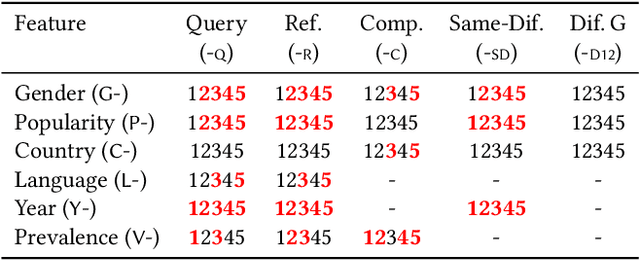
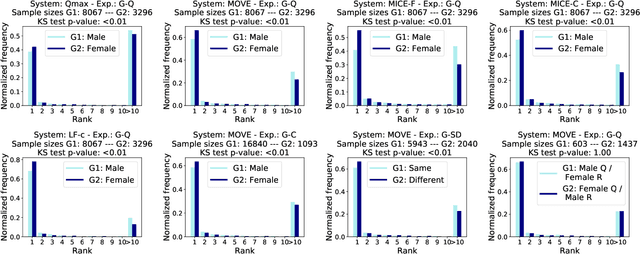
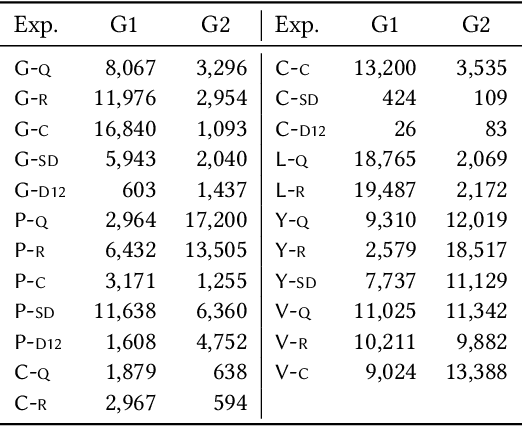
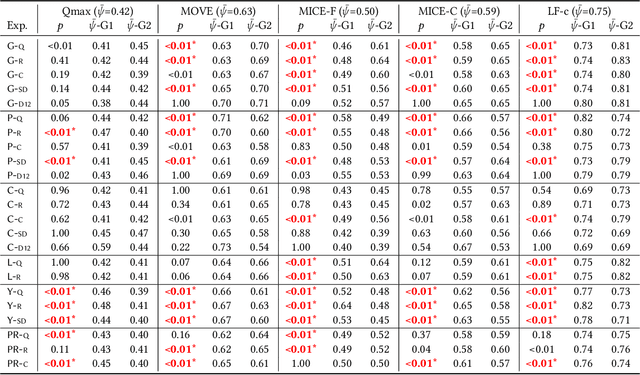
Abstract:Version identification (VI) systems now offer accurate and scalable solutions for detecting different renditions of a musical composition, allowing the use of these systems in industrial applications and throughout the wider music ecosystem. Such use can have an important impact on various stakeholders regarding recognition and financial benefits, including how royalties are circulated for digital rights management. In this work, we take a step toward acknowledging this impact and consider VI systems as socio-technical systems rather than isolated technologies. We propose a framework for quantifying performance disparities across 5 systems and 6 relevant side attributes: gender, popularity, country, language, year, and prevalence. We also consider 3 main stakeholders for this particular information retrieval use case: the performing artists of query tracks, those of reference (original) tracks, and the composers. By categorizing the recordings in our dataset using such attributes and stakeholders, we analyze whether the considered VI systems show any implicit biases. We find signs of disparities in identification performance for most of the groups we include in our analyses. Moreover, we also find that learning- and rule-based systems behave differently for some attributes, which suggests an additional dimension to consider along with accuracy and scalability when evaluating VI systems. Lastly, we share our dataset with attribute annotations to encourage VI researchers to take these aspects into account while building new systems.
 Add to Chrome
Add to Chrome Add to Firefox
Add to Firefox Add to Edge
Add to Edge